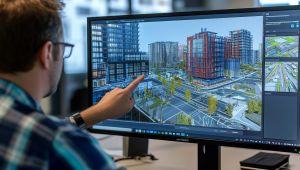Digital models of historic buildings help us keep the past alive in a modern way. 3D technology allows us to study and preserve important architectural works without harming the actual sites. These models are useful for education, restoration, and sharing heritage with people worldwide. Our collection includes detailed replicas of famous buildings that you can explore from anywhere, making learning about history interactive and accessible.
Capturing History in Precise Detail
Creating a historic preservation 3D model requires a high level of accuracy. These models help preserve the structural details of antique buildings and monuments, allowing users to examine them closely. With 3D technology, historians and architects gain access to every part of a building, from its exterior design to its interior layouts. This technology is valuable for restoring their original appearance as closely as possible.
- Key uses of these models include:
- Providing reference points for future restorations
- Offering a detailed view of hard-to-reach architectural elements
- Ensuring that the historic essence of a structure remains intact
Antique architecture 3D models give us a new way to look at history. They can capture even the smallest details that define these structures, such as carved reliefs or unique construction techniques. This accuracy is particularly useful for architects and preservationists, who can use these models to ensure their work stays faithful to the original structure.
Virtual Access to Cultural Sites
Digital models bring the world’s historic sites directly to users, making these sites accessible to a wider audience. Creating 3D model monument collections allows cultural heritage to be studied and enjoyed without travel or physical contact. This virtual accessibility also helps reduce wear on delicate structures, preserving them for future generations. Digital models provide students, researchers, and enthusiasts with unique learning opportunities and make it easy for them to interact with history directly.
- Advantages of virtual models:
- Access to historic sites from anywhere in the world
- Reduced impact on the actual monuments
- Detailed models for academic and research purposes
With cultural heritage 3D models, users can experience the value and complexity of historic architecture. This experience is visually immersive and helps users understand historical buildings from every angle. Museums, schools, and online platforms all use 3D models to enhance learning and allow students to study without physically visiting a site.
Detailed Restoration Planning
Planning to restore historic sites is complex, and 3D models significantly simplify this process. A heritage building 3D model offers a full-scale digital reference for restorers, allowing them to plan without needing physical site visits. This approach helps preserve the site’s integrity by reducing the onsite work needed. Preservationists can use these digital references to understand the layout and construction methods of the building, which improves accuracy and helps maintain its historical essence.
- Benefits for restoration:
- Accurate reference points for planning
- Less physical interference with the building
- Clear layout for complex historic structures
3D model monument technology allows preservationists to view a building’s intricate details without physically handling it. This is important for fragile sites or structures in difficult locations. Restoration professionals can ensure their work closely aligns with the building’s original design, keeping its historical appearance intact.
Teaching History with Digital Models
Using heritage building 3D models in educational settings has transformed how students learn about historic architecture. Students can now interact with accurate digital models of monuments, giving them insights into cultural heritage without leaving their classrooms. This way of learning is engaging and provides a hands-on experience with historic sites. Universities and schools use these models to complement their history, art, and architecture courses.
- Teaching applications:
- Digital field trips for classes
- Interactive learning experiences
- Visual aids for art and history lessons
Historic preservation 3D model collections are valuable for students studying architectural styles, materials, and methods. This digital access helps bridge the gap between theory and practical understanding. Instead of looking at photographs or diagrams, students can explore accurate digital models that showcase the building’s real form and design.
Global Sharing of Heritage
Through cultural heritage 3D models, historic architecture can be shared with audiences worldwide. These models make it easy for users from different backgrounds to explore cultural heritage and historic buildings without physically visiting them. This global access to history builds appreciation and understanding of diverse architectural styles and cultural landmarks.
- Advantages of global access:
- Appreciation of worldwide architecture
- Easy access for scholars and researchers
- Preservation of global cultural heritage
Heritage building 3D model collections help institutions, museums, and educational organizations share historic architecture with a broad audience. By making these digital models accessible, historic architecture can be appreciated and studied in different countries. Digital access to historic buildings is especially useful for students and researchers who might not have the opportunity to visit these sites in person.
Modeling and Preserving Details
Digital modeling of historic architecture allows us to document structures in a way that is clear, detailed, and easily accessible. This approach is crucial for rare architectural forms that are no longer common or for materials that require special care. Antique architecture 3D models are valuable in preserving these details and ensuring that the unique aspects of these buildings are available for future study.
- Key benefits of modeling:
- Documenting intricate architectural details
- Preventing loss of design knowledge
- Creating a permanent digital record
Historic preservation 3D model technology allows users to document designs that might be forgotten or altered over time. The detailed records created with 3D models serve as a lasting archive, making studying or replicating these architectural details easier.
 How To Make Your CGI Walls More RealisticRealistic walls with noise modifier.
How To Make Your CGI Walls More RealisticRealistic walls with noise modifier. Removing LUTs from Textures for better resultsRemove the LUT from a specific texture in order to get perfect looking textures in your render.
Removing LUTs from Textures for better resultsRemove the LUT from a specific texture in order to get perfect looking textures in your render. Chaos Corona 12 ReleasedWhat new features landed in Corona 12?
Chaos Corona 12 ReleasedWhat new features landed in Corona 12? OCIO Color Management in 3ds Max 2024Color management is crucial for full control over your renders.
OCIO Color Management in 3ds Max 2024Color management is crucial for full control over your renders. A look at 3dsMax Video SequencerDo you know that you can edit your videos directly in 3ds Max? Renderram is showing some functionalities of 3ds Max's built in sequencer.
A look at 3dsMax Video SequencerDo you know that you can edit your videos directly in 3ds Max? Renderram is showing some functionalities of 3ds Max's built in sequencer. FStorm Denoiser is here - First ImpressionsFirst look at new denoising tool in FStorm that will clean-up your renders.
FStorm Denoiser is here - First ImpressionsFirst look at new denoising tool in FStorm that will clean-up your renders.Customer zone
Your orders
Edit account
Add project
Liked projects
View your artist profile























COMMENTS